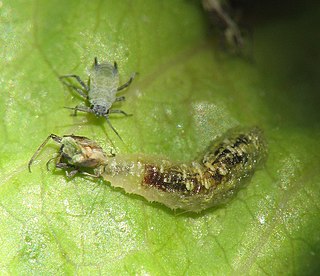
Biological control or biocontrol is a method of controlling pests, whether pest animals such as insects and mites, weeds, or pathogens affecting animals or plants by using other organisms. It relies on predation, parasitism, herbivory, or other natural mechanisms, but typically also involves an active human management role. It can be an important component of integrated pest management (IPM) programs.

Beauveria bassiana is a fungus that grows naturally in soils throughout the world and acts as a parasite on various arthropod species, causing white muscardine disease; it thus belongs to the group of entomopathogenic fungi. It is used as a biological insecticide to control a number of pests, including termites, thrips, whiteflies, aphids and various beetles. Its use in the control of bed bugs and malaria-transmitting mosquitos is under investigation.
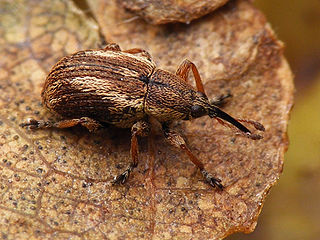
Exapion fuscirostre is a species of straight-snouted weevil known by the general common name Scotch broom seed weevil. It is used as an agent of biological pest control against the noxious weed known as Scotch broom.

Cyrtobagous salviniae is a species of weevil known as the salvinia weevil. It is used as an agent of biological pest control against the noxious aquatic plant giant salvinia.
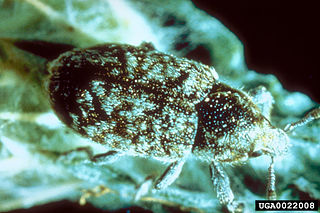
Bangasternus fausti is a species of true weevil known as the broad-nosed seed head weevil. It is used as an agent of biological pest control against noxious knapweeds, particularly spotted knapweed, squarrose knapweed, and diffuse knapweed.

Cyphocleonus achates is a species of true weevil known as the knapweed root weevil. It is native to southern Europe and the Mediterranean and is used as an agent of biological pest control against noxious knapweeds, especially spotted knapweed. It has recently been spotted in India.

Larinus minutus is a species of true weevil known as the lesser knapweed flower weevil. It is used as an agent of biological pest control against noxious knapweeds, especially diffuse knapweed and spotted knapweed.

Larinus obtusus is a species of true weevil known as the blunt knapweed flower weevil. It is used as an agent of biological pest control against noxious knapweeds, especially spotted knapweed.

Rhinocyllus conicus is a species of true weevil. It is best known as a controversial agent of biological pest control which has been used against noxious thistles in the genera Carduus, Cirsium, Onopordum, and Silybum.
Bangasternus orientalis is a species of true weevil known as the yellow starthistle bud weevil. It is used as an agent of biological pest control against the noxious weed yellow starthistle.

Eustenopus villosus is a species of true weevil known as the yellow starthistle hairy weevil. It is used as an agent of biological pest control against the noxious weed yellow starthistle.

Larinus curtus is a species of true weevil known as the yellow starthistle flower weevil. It is native to Southern Italy, Southern Europe, the Middle East and the Caucasus. It is used as an agent of biological pest control against the noxious weed yellow starthistle in the United States.

Urophora affinis is a species of tephritid or fruit flies in the genus Urophora of the family Tephritidae. It has been released in the United States and Canada as a biocontrol agent to control spotted knapweed. U. affinis became established in Montana in 1973.
Anthonomus santacruzi is a species of weevil that is a promising biocontrol agent for Solanum mauritianum, a major ecological weed in high-rainfall regions of South Africa.

Nastus is a genus of broad-nosed weevils in the beetle family Curculionidae. There are more than 30 described species in Nastus.
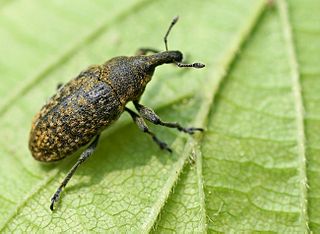
Larinus planus is an insect of the Curculionidae family. They are oval shaped, dark brown or black, and about 5–10 millimetres long. While native to Europe, it is also common in North America. It feeds on floral buds, primarily of thistles, with the larvae stage being the most destructive to them. In North America, it has been used as a biocontrol agent. It is also known as Larinus carlinae.

Ceutorhynchini is a true weevil tribe in the subfamily Baridinae.
Omias is a genus of broad-nosed weevils in the beetle family Curculionidae. There are more than 50 described species in Omias.
Tariq Butt is a British entomologist. He is a Professor of Biosciences at Swansea University in Wales.
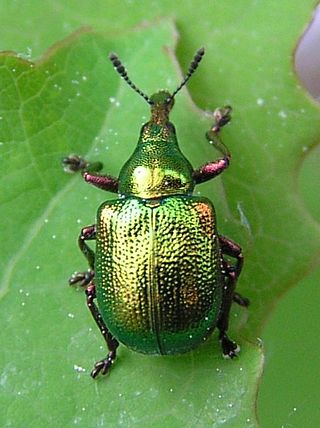
Byctiscus is a genus of beetles belonging to the family Attelabidae. Species of the genus are found in Europe and Japan.
















